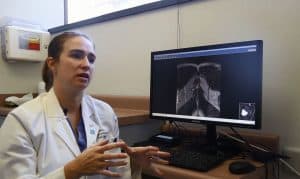Pelvic Pain Relieved by Interventional Radiologist
| Oct. 3, 2016 | Dealing with constant pelvic pain, Andie Marmorato of Cabot heard plenty of theories from doctors, but what she was lacking was answers.
That changed when she was referred to Mollie Meek, M.D., an interventional radiologist and associate professor in the College of Medicine at UAMS.
Marmorato said the pain — imagine bad cramps all the time — was affecting her quality of life.
“I’m 24 years old. I want to go and do and be,” Marmorato said. “And I just — couldn’t anymore. And Dr. Meek fixed all that for me.”

Mollie Meek, M.D., shows Marmorato’s scans, which confirmed that she had pelvic congestion syndrome, a painful condition that results in varicose veins inside the pelvis.
Marmorato’s symptoms led Meek to suspect a condition called pelvic congestion syndrome. An MRI confirmed the chronic condition, caused by varicose veins — which are gnarled, enlarged veins that can cause aching and discomfort — in the lower abdomen.
In Marmorato’s case, she had varicose veins all around her uterus and bladder. They developed because the vein that drains blood from the left side of her pelvis wasn’t functioning properly, so the blood was pooling inside her.
In addition to cramping, Meek said patients often describe the symptoms as a heaviness, pain or pressure in the pelvis that gets worse toward the end of the day and feels relieved when lying down. Intercourse and menstruation make the symptoms worse.
Meek said that among patients with pelvic pain, pelvic congestion syndrome is the culprit up to 30 percent of the time.
“It’s common, but people don’t know about it. The good thing is that it can be treated,” Meek said.
There can be many causes of pelvic pain, so narrowing down a pelvic congestion syndrome diagnosis can take time. Thankfully, however, the fix is simple. Meek used minimally invasive surgery that allowed her to thread a catheter through Marmorato’s right femoral vein to the malfunctioning vein and apply a medication that burned it closed. This forced the blood to flow in the correct direction and stop pooling in her pelvis.

Andie Marmorato was able to go on a vacation cruise shortly after having surgery for pelvic congestion syndrome.
Marmorato said it was a relief to see Meek spring into action with a clear plan that would relieve the pain and not affect her fertility. A previous physician had told her that might not be possible.
“My dream has always been to be a mother and a wife,” Marmorato said. “And when they told me that the chances of that happening weren’t very likely, I was devastated. I had never been that upset before.”
Meek said patients usually feel pain for three to five days after the procedure then gradually feel better.
A month after her surgery Marmorato was pain free and had just returned from a vacation cruise when she returned for a checkup
“I feel great,” Marmorato said. “I feel very happy. I feel like great weight has been lifted.”
Meek works out of the Interventional Radiology Clinic at UAMS.
